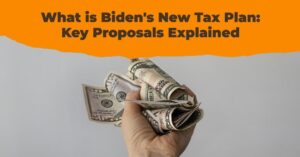President Biden's new tax plan, part of his Fiscal Year 2025 budget proposal, has been a topic of significant discussion and analysis. The plan aims to address various economic goals, including reducing the deficit, investing in America, and ensuring that large corporations and wealthy individuals contribute their fair share to the nation's finances.
Key Proposals in the New Tax Plan:
- Increased Taxes on High Earners: One of the central elements of the plan is the imposition of additional taxes on high earners. This includes raising the top marginal income tax rate to 39.6% for single filers earning more than $400,000 and married couples with incomes above $450,000.
- Corporate Tax Rate Hike: The corporate tax rate is proposed to be increased to 28%, which is a significant change from the current rate. This move is expected to be the largest driver of the plan's long-term economic impact, potentially reducing GDP growth, the capital stock, wages, and full-time equivalent jobs.
- Minimum Tax on Billionaires: A new billionaire minimum tax is proposed to ensure that the wealthiest Americans do not avoid paying taxes on their accumulated wealth. This would apply to individuals with wealth exceeding $100 million.
- Tax Credits and Incentives: The plan also includes various tax credits and incentives aimed at middle-class families and working Americans. These measures are designed to provide relief and support for those earning less than $400,000 annually.
- Crackdown on Tax Evasion: Strengthening the Internal Revenue Service (IRS) to crack down on tax evasion is another critical aspect of the plan. The goal is to ensure that all Americans, regardless of income level, pay the taxes they owe.
Economic Impact:
The Tax Foundation has provided a detailed analysis of the plan's potential economic impact. Their preliminary estimates suggest that the tax increases could lead to a reduction in long-run GDP by 2.2%, a decrease in wages by 1.6%, and a loss of approximately 788,000 full-time equivalent jobs. The increase in the corporate tax rate is projected to have the most significant negative effect on the economy.
However, the White House has emphasized that the plan will deliver tax cuts for families with children and working Americans while reducing deficits by trillions of dollars. The administration argues that the proposed changes will make the tax system fairer and more equitable.
Comparing President Biden's Tax Plan to Previous Administrations
President Biden's tax plan, as outlined in his Fiscal Year 2025 budget proposal, marks a significant shift from the policies of previous administrations. Here's a comparative look at how Biden's approach diverges from his predecessors:
- Reversal of the 2017 Tax Cuts and Jobs Act: President Biden's proposal seeks to partially reverse the tax cuts implemented under the 2017 Tax Cuts and Jobs Act (TCJA) enacted during President Trump's administration. The TCJA significantly lowered the corporate tax rate from 35% to 21% and also reduced individual income tax rates. Biden's plan aims to increase the corporate tax rate to 28% and restore the top individual income tax rate to 39.6% for high earners.
- Focus on High-Income Earners and Corporations: Unlike the TCJA, which provided tax cuts across the board, Biden's plan targets tax increases primarily at corporations and individuals earning more than $400,000 per year. This is in line with his administration's goal of ensuring that the wealthiest Americans pay their fair share of taxes.
- Expansion of Tax Credits: Biden's plan includes proposals to expand tax credits such as the Earned Income Tax Credit (EITC) and the Child Tax Credit (CTC), providing additional support to lower- and middle-income households. This contrasts with the TCJA, which did not focus as much on expanding these credits.
- Tax Enforcement and Compliance: A notable aspect of Biden's plan is the emphasis on strengthening tax enforcement to reduce tax evasion. This includes providing additional resources to the Internal Revenue Service (IRS) for enforcement activities. The approach under previous administrations, particularly under President Trump, did not prioritize IRS funding to the same extent.
- Economic Impact: The economic impact of Biden's tax plan is projected to be different from that of the TCJA. While the TCJA was expected to stimulate economic growth, albeit with mixed results, Biden's plan is estimated to potentially reduce long-run GDP and result in job losses. However, it also aims to reduce the deficit and provide tax relief to middle-class families.
- Comparison with President Obama's Policies: President Obama's tax policies were characterized by a mix of moderate spending reductions and revenue increases, with the primary goal of stabilizing and reducing the federal debt as a share of GDP. Biden's plan shares some similarities with Obama's approach, especially in terms of increasing taxes on high earners and corporations. However, Biden's proposals are more aggressive in terms of the rate increases and the scope of tax enforcement.
In summary, President Biden's tax plan represents a departure from the tax policies of the Trump administration and aligns more closely with the progressive tax policies of the Obama era, albeit with more assertive measures. The plan's focus on high-income earners and corporations, expansion of tax credits, and enhanced tax enforcement are key differentiators from previous policies. As the plan progresses through the legislative process, its final form and impact will be closely watched by policymakers, economists, and the public alike.

 If you're self-employed or have a small business, the idea of a 401(k) may make you jump to two conclusions: “My company is too small” or “I can’t afford it.” Well, you’re not too small and you can afford it!
If you're self-employed or have a small business, the idea of a 401(k) may make you jump to two conclusions: “My company is too small” or “I can’t afford it.” Well, you’re not too small and you can afford it!